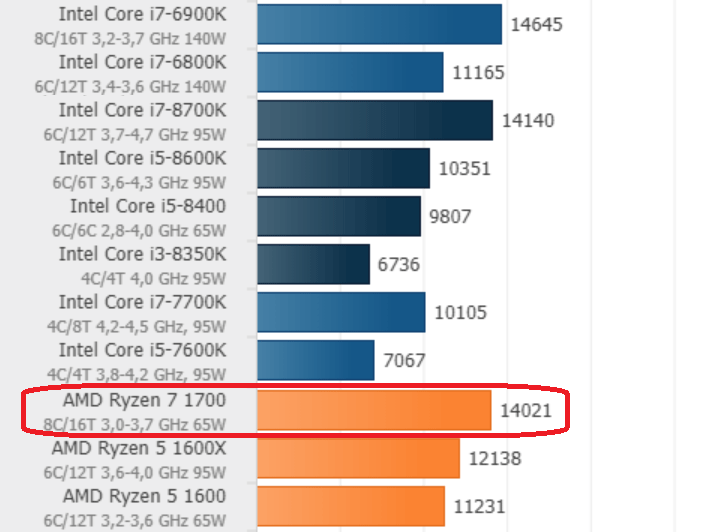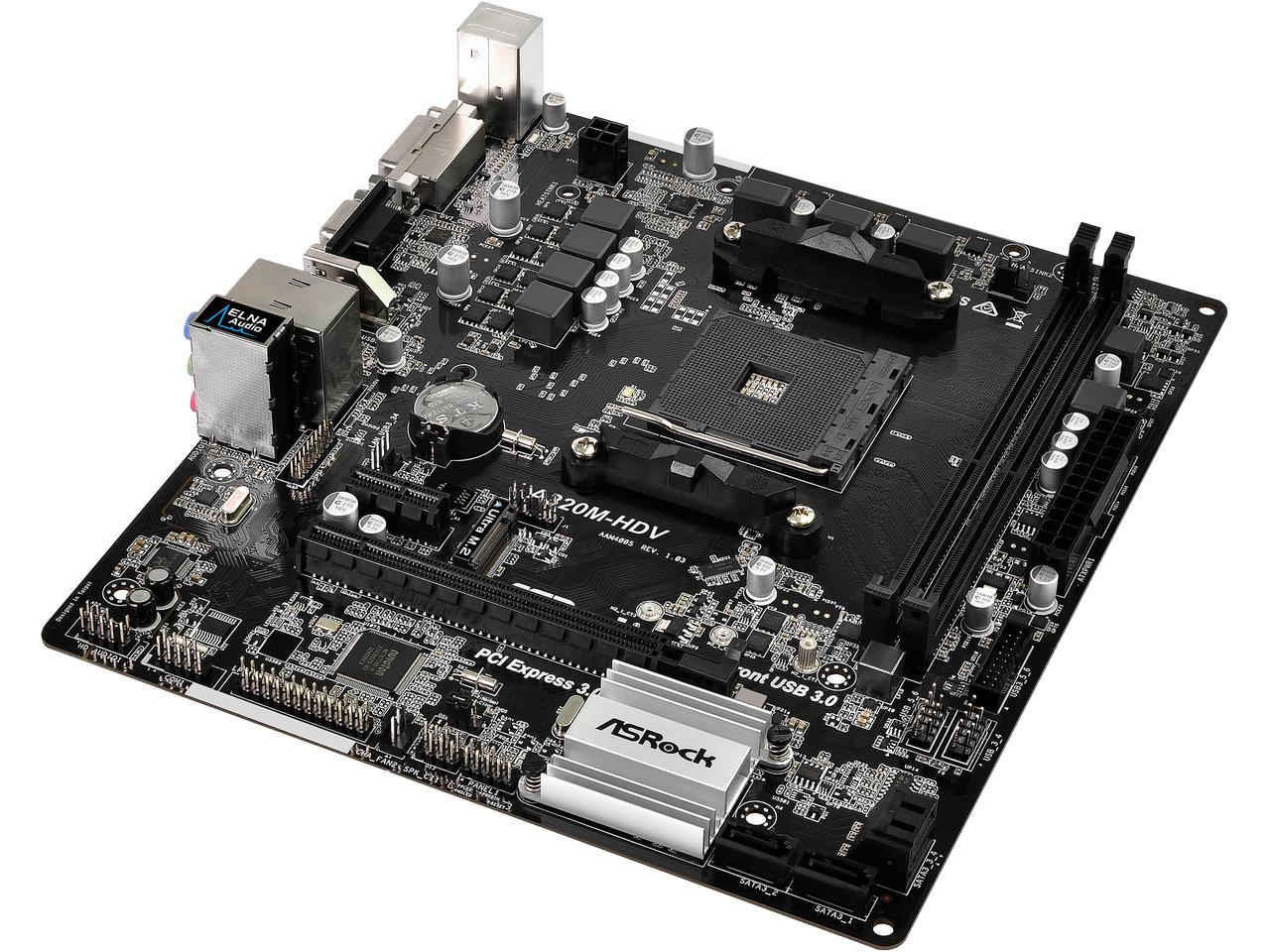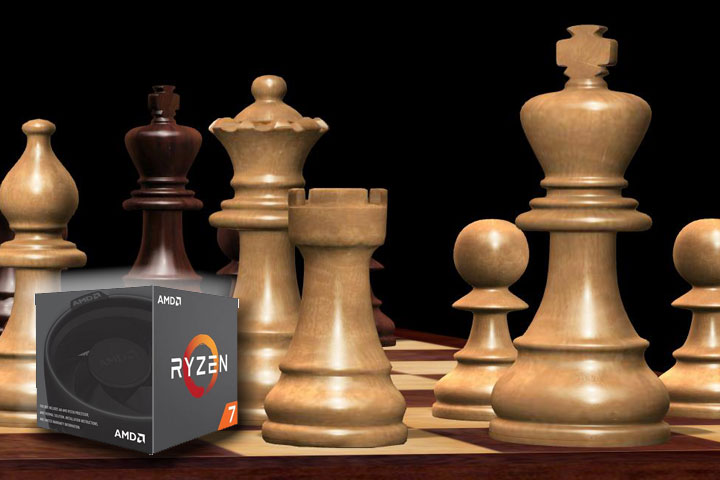Obviously, when setting a limit of $2500, it is not hard to go 1st class the whole way, provided no single component eats up the lion’s share of the amount allotted. However, not everyone is fortunate enough to be able to spend that much on a computer for chess, or wants to. This doesn’t mean they don’t also desire great chess performance. The question is therefore: how frugal can one be before sacrifices made maim the configuration too much to call it a ‘Power Chess Machine’?
The answer is one can build a complete, brand new octa-core PC for just $500. There is no question some hard choices are made for this to work, but in the end you will have a full-fledged machine running one of the latest generation octa-core processors from the AMD Ryzen line.

The AMD Ryzen 7 1700 has unparalleled chess performance within its price range | Photo: AMD
The configuration below is not set in stone, and comes with product links to NewEgg. There are no referral codes in these links, and they are merely for illustrative purposes and the option to get full product page specifications and images of each component. After the list, comments will be made on some of the choices, as well as some inexpensive options to upgrade.
The $500 Chess Machine
| Component |
Model |
Price |
| CPU / Processor |
AMD Ryzen 7 1700 8-Core |
$270 |
| Motherboard |
ASRock A320M-HDV AM4 |
$50 |
| Memory |
CORSAIR Vengeance LPX 8GB DDR4 2400 |
$75 |
| Hard disk |
Western Digital Green 500GB |
$25 |
| Video card |
GIGABYTE GeForce GT 710 GV-N710D5-1GI 1GB GDDR5 |
$40 |
| Micro ATX tower |
Rosewill - Dual-Fan Micro ATX Tower - Ranger-M |
$20 |
| Power supply |
Rosewill 350W ATX RV350-2 |
$30 |
Total: $510
The first thing to realize is that the machine has been designed to not only be powerful, but also small, and with low power consumption.
The main draw here is obviously the octa-core AMD Ryzen 7 1700 processor, which can provide similar chess analysis to even the very best Intel processors. Running Komodo, it achieves similar KNPs (thousands of positions per second – or in this case millions) to the Intel i7-6900K, a processor that retails for over $1000 alone. This AMD model also has two further benefits: it comes with its own excellent cooler, and it runs on a very modest 65W TDP.

Here is a comparison in KNPs of Komodo on the recommended CPU, and other contenders | Photo: Hardware.fr
The multiple computer chess world champion comes in a new and yet more powerful version. Thanks to co-author US Grandmaster Larry Kaufman, Komodo is the strategist among the top chess programs!
The memory chosen is a single 8GB memory card, allowing an upgrade to 16GB at a later date. Bear in mind the motherboard only has room for two memory cards, so if you fill it with two 4GB cards, the only way to upgrade is to replace them.

A Micro ATX motherboard and build is more than sufficient and will allow for lower power consumption and less space taken. Not to mention cost-saving. | Photo: ASRock
The hard disk is a modest 500GB, however for all basic purposes it is far more than enough. An operating system, basic programs such as Microsoft Office, the chess software and databases, and even some extra professional programs such as those by Adobe, will not take up even half of the storage. Feel free to upgrade this to 1TB for $15 more, or even larger. And of course you can always add an external HD later if you just want to store things like movies, music or more.
Houdini 6 continues where its predecessor left off, and adds solid 60 Elo points to this formidable engine, once again making Houdini the strongest chess program currently available on the market.
The video card is a modern low-profile card with no fans (thus no noise too), connections for multiple monitors, or a monitor and a TV, and 1GB of video memory. You can also consider spending $9 more for a 2GB version of this card. This extra video memory does have its uses, especially if you are the type of person to open many tabs in your browser (I am so very guilty of this myself).

A microATX tower need not be ugly, but will take up a lot less space than a larger case. Komodo, Houdini or Stickfish will run just as fast in it as in a larger setup | Photo: Rosewill
The microATX tower is an inexpensive choice that can house a normal sized power supply. Any decent model is fine, and can be found easily in the $20-$30 range. Aside from aesthetics, make sure it has decent ventilation, and USB ports that can be accessed easily. Avoid choosing one that comes with its own power supply. As a rule the power supply in such cases is the bottom of the barrel, and this can compromise the entire computer.
The power supply chosen is 350W model by Rosewill, which is actually more than the system should need, but will help ensure stability. The brand is not important here, since most of the big name makers don’t actually work with such low power supplies anymore.
And there you have it: a powerful lean mean chess machine with eight cores and massive chess performance for just $500 ($510 for the chronic nitpickers), that will not only provide great analysis, but will also give great results in pretty much anything.



























